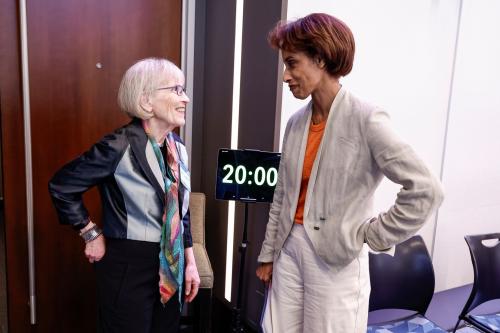Executive summary
In the United States, eligible older adults are accessing means-tested safety net programs at low rates. Particularly, the participation rates of older adults in Supplemental Security Income (SSI) and the Supplemental Nutrition Assistance Program (SNAP) are exceedingly low. Recent data reveals that less than half of eligible adults ages 60 and older participated in SNAP in 2018. Although the recipiency of SSI among older adults is understudied, estimates indicate that since the program’s inception in the 1970s, their participation rate has hovered around 50%.
Participation rates in these programs are low, even with the existence of many outreach efforts. Examples include the SSI/Social Security Disability Insurance (SSDI) Outreach, Access, and Recovery (SOAR) model designed to increase participation among individuals who are experiencing or at risk of homelessness, and SNAP outreach that occurs at local food banks and pantries across the United States. Current application, determination, and enrollment processes for these programs involve numerous administrative barriers that, along with other factors, result in many individuals, including older adults, from accessing their entitled benefits. In addition, many program rules further discourage participation.
The financial situation of many low-income older adults, given that their income tends to remain generally constant over time, allows for a unique opportunity to reform application and enrollment processes for this specific population. The provisions outlined in this brief apply to beneficiaries receiving SSDI, in addition to older adults. As previously proposed to reduce Medicare premiums, a more automated approach can be applied to the application processes of SSI and SNAP. This reform would be a radical change from current program operations and is likely to result in higher participation rates in both programs. In this brief, we examine in greater detail the current levels of SSI and SNAP enrollment among older adults, illustrate why participation rates are stubbornly low, and describe a solution to this problem.
Framing the problem
Supplemental Security Income (SSI) is a federal program which provides monthly benefits to older adults and people with disabilities who have limited income and resources. SSI is an extremely important source of support for a large group of individuals, with a significant share relying on the program entirely for their income. In 2022, nearly 2.6 million adults ages 65 or older received at least one SSI payment during the year. In December of that year, about 37 % of those recipients received no other income besides SSI. Another safety net program, the Supplemental Nutrition Assistance Program (SNAP), is the largest federal nutrition assistance program, providing food benefits to low-income individuals and families. About 9.5 million adults ages 50 or older participated in SNAP in 2018. Strong nutrition is important to healthy aging, and participation in SNAP has been associated with fewer inpatient admissions, emergency department visits, and long-term care admissions for low-income older adults dually eligible for Medicare and Medicaid.
However, despite the importance of SSI and SNAP in supporting older adults, participation rates in both programs are strikingly low. Although participation rates in SSI among older adults are understudied, with most recent available data being from 2015, the best estimates point to a participation rate of about 50% among this population since the program’s inception in the 1970s. Older adults have also historically had low participation rates in SNAP and are underrepresented among SNAP recipients. From 2010 to 2020, adults over age 60 have had a lower participation rate than that of adults between 18 and 59 years old. In 2018, this translated to only about 48% of adults ages 60 and older who were eligible for SNAP benefits participating in the program. Ultimately, 63% of potential benefits to eligible older adults are received, which is the lowest benefit receipt rate across age groups. The benefit receipt rate of 63% is higher than the participation rate of 48% because poorer older adults, who qualify for larger SNAP benefits, participate at higher rates than older adults who are higher on the SNAP income-eligibility scale and qualify for smaller SNAP benefits.
These low participation rates in SSI and SNAP suggest that many older adults are missing out on a meaningful amount of assistance. About 20% of eligible non-participants of SNAP ages 50 and older would receive more than $200 in benefits per month, with 14% eligible for more than $300 per month. Additionally, according to the AARP Public Policy Institute, 2.1 million SNAP eligible non-participants ages 50 and older have incomes at or below 50% of the federal poverty level (FPL).1 Amidst rising levels of food insecurity among older adults, particularly among those ages 80 and older, ensuring that eligible individuals receive benefits is critical. The same applies to income support programs such as SSI. Just over 14% of adults ages 65 and older lived below the poverty level in 2022 according to the supplemental poverty measure, representing the highest poverty rate among this population since 2016.
Safety net programs are designed to provide assistance to individuals during periods of economic insecurity, yet current policies make it difficult for many individuals to access this support when they need it. Low participation in SNAP and SSI are likely related to the high levels of administrative burden associated with receiving benefits from each program. Administrative burdens tend to most significantly impact marginalized individuals. For example, people with lower income tend to face larger barriers in applying for and receiving low-income related support compared to the application and enrollment processes of programs utilized by people of higher socioeconomic status. Beyond this, administrative burdens tend to have the largest impact on people with worse medical conditions and lower prior earnings, which are characteristics of the population that both SNAP and SSI serve. Previously, administrative burdens have been cited directly as leading many older adults to incorrectly believe they are ineligible for SNAP benefits. Beyond administrative burdens causing program rules and the application process to be unclear, stigma and discomfort with technology have also been identified as reasons for low participation in SNAP among older adults. Additionally, underfunding and understaffing of SSA has led to delayed application and determination processes, exacerbating burdens faced by SSI beneficiaries.
These administrative burdens manifest through onerous determination processes and program rules. Eligibility for SSI is determined by income and the value of assets. In SSI, the in-kind support and maintenance (ISM) and asset rules particularly discourage participation in the program. ISM refers to assistance that an individual receives that is paid for by someone else. An individual’s SSI benefit may be reduced by a significant amount if they receive help with shelter and many other living expenses, or live in a non-medical institution such as a retirement home. Beginning in September 2024, food will be excluded from in-kind support calculations, lessening the restrictiveness of this determination process slightly. Regardless, due to ISM rules, many caregiving and living arrangements reduce an older adult’s benefit level.
Stringent asset limits also pose barriers to SSI applicants and beneficiaries. Countable resources may not exceed $2,000 for an individual or $3,000 for a couple, a limit set in 1989 and not adjusted for inflation since. As previously highlighted by experts in SSI policy, these asset limits both prevent beneficiaries from saving in any meaningful way and contribute greatly to administrative inefficiencies within the Social Security Administration (SSA). The SSI Savings Penalty Elimination Act was introduced in the House and Senate at the end of 2023 with bipartisan support, and would increase resource limits significantly and update those limits annually for inflation.
Overall, under current program administration, access to SSI and SNAP among older adults is far more difficult than it should be. SSI and SNAP benefits contribute meaningfully to the economic and physical well-being of those who receive them. All eligible older adults should be able to access the benefits to which they are entitled. In future publications, we will present additional policy changes to strengthen safety net programs for low-income older adults. Meanwhile, in this brief, we propose completely overhauling the current program application processes for older adults, thereby increasing participation rates among this population significantly.
All eligible older adults should be able to access the benefits to which they are entitled...We propose completely overhauling the current program application processes for older adults, thereby increasing participation rates among this population significantly.
Proposed solution
Simplified enrollment procedures can greatly increase participation rates. This simplified procedure can be modeled after processes currently employed in other government programs, such as the administration of the low-income subsidy program in Medicare Part D and the program that administers the income-related premium for high-income Medicare beneficiaries. This mechanism has been carefully described previously as a way to reduce Medicare premiums for low-income Medicare beneficiaries, and can be applied broadly to a wide range of programs including SNAP and SSI. The procedures outlined in this section would apply to older adults ages 65 and older and disabled individuals receiving SSDI.2
Today, the Internal Revenue Service (IRS) electronically provides SSA with tax information to determine which enrollees must pay the Medicare income-related premium. This tax information can be used more expansively. First, in the administration of SSI, income data would be taken from the potential beneficiary’s tax return. If no income tax return has been filed, the IRS would share any form 1099 income reports for the potential beneficiary with SSA, and SSA would assume their income equals their Social Security and form 1099 income. In cases where no tax return is available, SSA would check with the potential beneficiary to determine whether the individual had other income and require it to be reported. Based on the income calculated, potential beneficiaries would receive a notice from SSA outlining whether they meet the income eligibility limits of SSI, and be prompted to share more information about their assets.3 Many older adults have limited assets, with about 7.6 million having less than $20,000 in household assets in 2020.4
Under this proposal, SSA would be responsible for administering SNAP benefits for a major component of the population of low-income adults ages 65 and older. Similar processes as outlined in the administration of SSI would occur in the administration of SNAP, however, specific resource information would be collected for the relevant countable resources and deductions. Given that income information comes from the IRS, there would be a 2-year accounting lag. Therefore, a beneficiary’s income and assets from two years prior determines their eligibility and benefit amount in the current period for SSI and SNAP. The basis of this proposal rests on the notion that this population most likely does not have large fluctuations in income from year to year.
The automatic income-eligibility determinations should increase participation rates greatly. Considering the automatic enrollment processes for the low-income subsidy in the Part D Medicare program as an example, the take-up rate is nearly universal for those who are automatically enrolled but is only about 30% for non-automatic enrollees. Although accompanying information on assets and resources is required in addition to income to make final eligibility determinations, implementing an enrollment process for SNAP and SSI that loops more older adults into the application pipeline based on income alone should attach more people to the enrollment process.
Certain rules governing the SSI and SNAP application processes must be modified to support the adoption of this new enrollment procedure. The accounting period of SSI and SNAP will be changed to one year.5 This change in accounting period is only applicable to those for whom SSA would be administering benefits. Furthermore, in relation to SNAP, duplicative use and household composition must be monitored. Because the new enrollment procedures envision SNAP for low-income older adults being administered by SSA, those individuals must not also be receiving benefits from their state agency that currently administers the program. Since the proposal would target older adults and disabled individuals, and not others who may be living in their household, SSA would only administer SNAP benefits as outlined in this proposal for older adults and disabled individuals who live in households composed entirely of people who are 65 or older or disabled. This household composition restriction does not apply to the proposed administration of SSI benefits. For SSI, the in-kind support and maintenance rule should be eliminated and the asset limit substantially increased, both to improve the outcomes for participants and enable SSA to execute the proposal. A lack of large fluctuations in income, paired with the use of a lagged accounting period, allows for a more straightforward income reporting, income verification, and oversight process for this group. Regardless, this new program has administrative costs associated with its rollout, and additional costs associated with more individuals being supported by the safety net. These costs will be offset by increases in the base and rate of the net income investment tax.
Policy implications
This policy proposal is a radical departure from the current administrative practices within SSI and SNAP. Particularly salient to SSI, previously many individuals have needed to utilize legal or other services to assist them with the application process due to the complexity of application forms. Additionally, for many years, there has been no online form for beneficiaries applying for SSI solely based on age, and benefits instead must usually be applied for in-person at a local Social Security office. The SSI application process has posed significant barriers to people, contributing to the strikingly low participation rate. Increasing automation in the SSI application and enrollment processes would further ease some of the administrative burdens associated with understaffing of SSA, such as long wait times and lack of personnel available to assist beneficiaries. Therefore, this proposal suggests a fundamental rethinking of how the program operates in the hopes of reducing significant barriers to eligible recipients in accessing their deserved benefits.
Another factor is that individuals are more likely to participate in safety net programs if they are eligible for a higher benefit level. This is the case in the SNAP program, as on average, eligible non-participating older adults would receive a lower SNAP benefit than those who are participating, given that non-participating households tend to have higher incomes. Therefore, a mechanism like the one proposed in this paper would help increase participation among this group, as a burdensome application process would no longer outweigh potential benefits. On the other hand, across the United States in 2020, surprisingly the share of people with household income under 50% FPL who receive SNAP was lower than the share of those in households with income between 50 and 100% FPL. Many people with household income below 50% FPL are eligible for a high benefit amount. As such, a more automated enrollment process in SNAP will ensure that many low-income older adults will be able to access their correct benefit amount, regardless of what that benefit level may be.
Furthermore, there is a SNAP access rate of over 80% among households that receive SSI. This may be due to these households having more awareness of SNAP and their potential eligibility for the program, or they may find it easier to navigate the application and enrollment processes. Currently, individuals applying for or receiving SSI are able to get an application for SNAP at their local Social Security office. In theory, SSA is supposed to help households receiving SSI complete a SNAP application and forward that application to a SNAP office for processing. In some states, for individuals that live alone, an SSI application may also function as a SNAP application. However, in practice, many individuals are not offered these services. This fact provides some evidence that an automatic enrollment process could further raise awareness for each program and encourage higher participation rates in each. The provision of additional resources to SSA would only bolster the success of implementing this policy. A more automated enrollment process would help to streamline application materials for both SSI and SNAP, ensuring that all eligible older adults are granted the same application resources.
Conclusion
Participation rates of SNAP and SSI are very low, at 50% or less. Current application and enrollment processes are failing our older adults, as the administrative burdens associated with them are preventing many from receiving the benefits they are entitled to. A more automated approach can be applied to the application processes of SSI and SNAP to increase participation rates of older adults in both programs. This reform would be a significant change to current program operations and would likely result in many more individuals accessing their eligible benefits. In employing a reformed application and enrollment process, SNAP and SSI will better support low-income older adults, as both programs are designed to do.
-
Acknowledgements and disclosures
The authors thank Bob Greenstein and Jack Smalligan for careful review and comments on an earlier draft of the brief. They also thank Ben Graham and Caitlin Rowley for excellent research and editorial assistance.
The Brookings Institution is financed through the support of a diverse array of foundations, corporations, governments, individuals, as well as an endowment. A list of donors can be found in our annual reports published online here. The findings, interpretations, and conclusions in this report are solely those of its author(s) and are not influenced by any donation.
-
Footnotes
- Due to SNAP participation being underreported in survey data, analyses estimate SNAP participation from SNAP Quality Control data and household characteristics from the Current Population Survey Annual Social and Economic Supplement data.
- When individuals initially apply for SSDI, SSA considers whether they are eligible for SSI. Once determined eligible for SSDI, a SSDI beneficiary initially found ineligible for SSI could subsequently begin to be eligible for SSI if their income or assets decreased.
- Given that both SSDI and SSI share one disability determination, this proposal assumes eligibility for SSI based on disability if an individual is already receiving SSDI benefits.
- Authors’ calculations of the Health and Retirement Study (HRS).
- Currently, SSI benefits are determined by monthly income. The SNAP certification period for many households is one year, and benefits do not fluctuate unless changes in household circumstances result in the loss of eligibility. Changes in monthly income may impact eligibility, however, this rarely occurs for older adults living on fixed incomes.







Commentary
Reducing poverty among older and disabled adults by increasing participation in SSI and SNAP
July 8, 2024